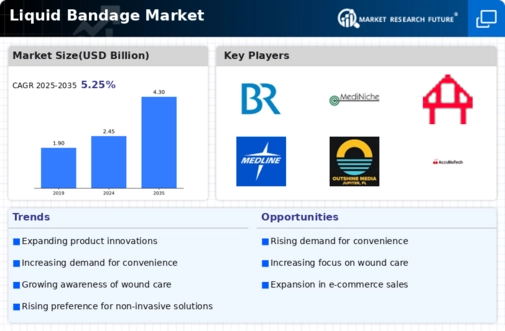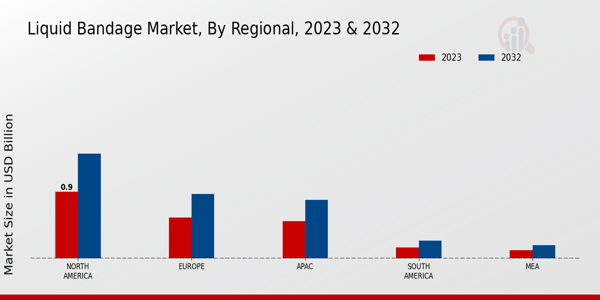Increasing Incidence of Minor Injuries
The Global Liquid Bandage Market Industry is significantly influenced by the rising incidence of minor injuries, such as cuts, scrapes, and abrasions. These injuries are prevalent across various demographics, including children and active adults. The convenience and effectiveness of liquid bandages make them a preferred choice for treating such injuries. As awareness about the importance of immediate care for minor wounds grows, the market is likely to expand further. This trend is expected to contribute to the overall growth of the industry, with projections indicating a market size of 4.3 USD Billion by 2035.
Rising Demand for Wound Care Solutions
The Global Liquid Bandage Market Industry is experiencing a notable increase in demand for advanced wound care solutions. This trend is driven by a growing awareness of the benefits of liquid bandages, which provide a protective barrier against infections while promoting faster healing. As healthcare providers and patients alike recognize the advantages of liquid bandages over traditional dressings, the market is projected to reach 2.45 USD Billion in 2024. This shift towards more efficient wound care options reflects a broader movement within the healthcare sector towards innovative and effective treatment modalities.
Expansion of Retail and E-commerce Channels
The Global Liquid Bandage Market Industry is benefiting from the expansion of retail and e-commerce channels. Increased accessibility to liquid bandage products through various platforms allows consumers to easily obtain these solutions for minor injuries. Retailers are increasingly stocking liquid bandages, and online platforms provide convenience for consumers seeking quick and effective wound care options. This accessibility is likely to enhance market penetration and drive sales growth. As consumer preferences shift towards online shopping, the industry is poised for significant growth, reflecting changing purchasing behaviors in the healthcare sector.
Technological Advancements in Medical Products
Technological innovations play a crucial role in shaping the Global Liquid Bandage Market Industry. The development of new formulations and application methods enhances the efficacy and usability of liquid bandages. For instance, advancements in polymer technology have led to the creation of liquid bandages that are more durable and provide better adhesion. These innovations not only improve patient outcomes but also expand the range of applications for liquid bandages, thereby driving market growth. As a result, the industry is expected to witness a compound annual growth rate of 5.26% from 2025 to 2035, indicating a robust future for liquid bandage products.
Growing Preference for Non-invasive Treatment Options
There is a discernible shift towards non-invasive treatment options within the Global Liquid Bandage Market Industry. Patients and healthcare providers increasingly favor solutions that minimize discomfort and promote healing without the need for invasive procedures. Liquid bandages align with this preference, offering a pain-free alternative to traditional wound dressings. This trend is particularly relevant in pediatric care, where minimizing trauma during treatment is paramount. As the market evolves to meet these demands, the adoption of liquid bandages is expected to rise, further solidifying their position in the wound care landscape.























Leave a Comment